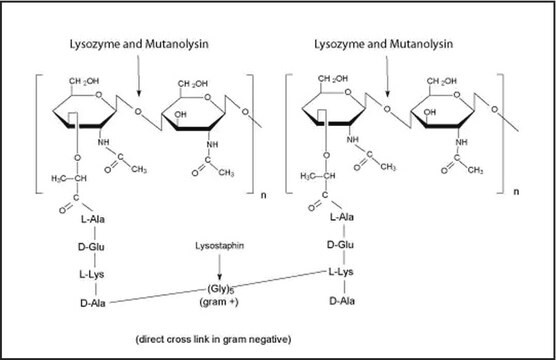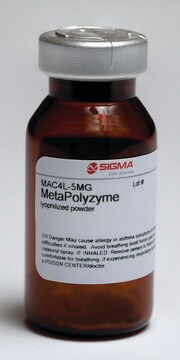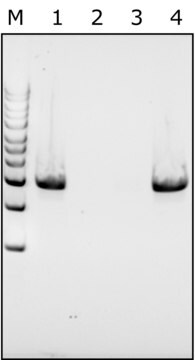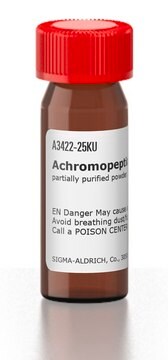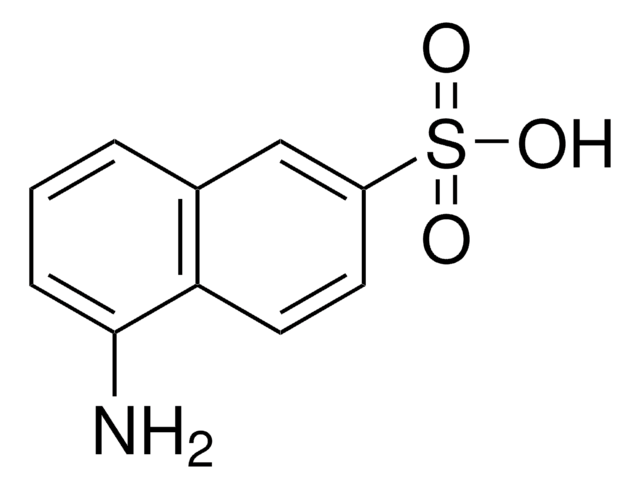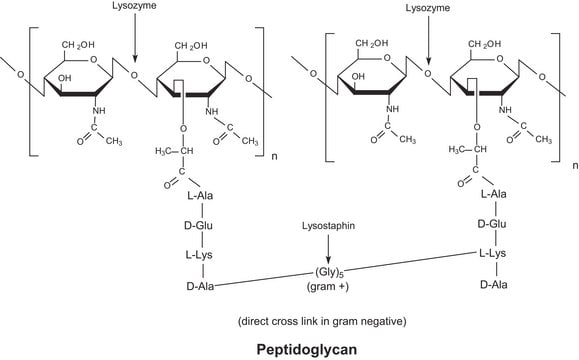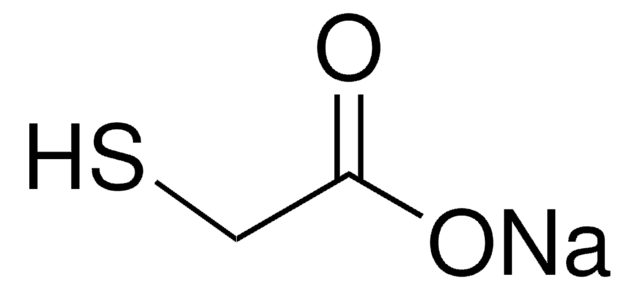L2898
Lysostaphin from Staphylococcus staphylolyticus
aseptically filled
Synonym(s):
Glycyl-glycine Endopeptidase
Sign Into View Organizational & Contract Pricing
All Photos(1)
About This Item
CAS Number:
MDL number:
UNSPSC Code:
12352204
NACRES:
NA.54
Recommended Products
sterility
aseptically filled
Quality Level
form
powder
specific activity
>500 units/mg protein
mol wt
25 kDa
composition
Protein, 40-70% biuret
antibiotic activity spectrum
Gram-positive bacteria
Mode of action
cell wall synthesis | interferes
storage temp.
−20°C
Looking for similar products? Visit Product Comparison Guide
General description
Chemical structure: peptide
Lysostaphin is mainly liberated as a proenzyme. It is highly stable at pH 4 and temperature 5°C.
Biochem/physiol Actions
Lysostaphin exhibit a lytic action against Staphylococcus aureus. It possesses several functions of three major enzymes, such as, glycylglycine endopeptidase, endo-β-N-acetyl glucosamidase and N-acteyl muramyl-L-alanine amidase. Lysostaphin can be used to treat antibiotic-resistant staphylococcal infections. Lysostaphin being an antistaphylococcal agent, can be used as a preservative in the food industry and in clinical labs for rapid screening.
Lysostaphin is a zinc endopeptidase with a molecular weight of approximately 25 kDa. Because lysostaphin cleaves the polyglycine cross-links in the peptidoglycan layer of the cell wall of Staphylococcus species it has been found useful for cell lysis and also as a potential anti-microbial therapeutic.
pH Optimum for activity: ~7.5
pH Optimum for activity: ~7.5
Unit Definition
One unit will reduce the turbidity (A620) of a suspension of Staphylococcus aureus cells from 0.250 to 0.125 in 10 min at pH 7.5 at 37 °C in a 6.0 ml reaction mixture.
Preparation Note
Prepared from L 7386
Signal Word
Danger
Hazard Statements
Precautionary Statements
Hazard Classifications
Resp. Sens. 1
Storage Class Code
11 - Combustible Solids
WGK
WGK 3
Flash Point(F)
Not applicable
Flash Point(C)
Not applicable
Personal Protective Equipment
dust mask type N95 (US), Eyeshields, Gloves
Choose from one of the most recent versions:
Already Own This Product?
Find documentation for the products that you have recently purchased in the Document Library.
Customers Also Viewed
Lysostaphin: an antistaphylococcal agent
Kumar J K
Applied Microbiology and Biotechnology, 80(4), 555-561 (2008)
Shaw R Gargis et al.
Applied and environmental microbiology, 76(20), 6944-6946 (2010-08-24)
Resistance to lysostaphin, a staphylolytic glycylglycine endopeptidase, is due to a FemABX-like immunity protein that inserts serines in place of some glycines in peptidoglycan cross bridges. These modifications inhibit both binding of the recombinant cell wall targeting domain and catalysis
Igor Belyansky et al.
The American surgeon, 77(8), 1025-1031 (2011-09-29)
Mesh and wound infections during hernia repair are predominantly caused by Staphylococcus aureus. Human acellular dermis (HAD) is known to lose its integrity in the face of large bacterial loads. The goal of this study was to determine if lysostaphin
Yuliya Yurko et al.
Surgical innovation, 19(1), 20-26 (2011-07-12)
Naturally occurring antimicrobial peptides are possibly the "next frontier" in infection prevention. Binding them to mesh could reduce the rate of mesh infections. This study identifies an antimicrobial agent capable of significant antibacterial activity when bound to mesh. Lysozyme, human
Lysostaphin and clarithromycin: a promising combination for the eradication of Staphylococcus aureus biofilms.
A Aguinaga et al.
International journal of antimicrobial agents, 37(6), 585-587 (2011-04-19)
Our team of scientists has experience in all areas of research including Life Science, Material Science, Chemical Synthesis, Chromatography, Analytical and many others.
Contact Technical Service



